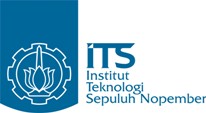Mathematical Modelling of Longitudinal Vibration on Propulsion System 5200 DWT General Cargo Ship
Abstract
The vibration level of the propulsion system will change during its operation. This vibration is caused by harmonic excitation forces produced by the rotation of the main engine and propeller shaft. Ship propulsion systems experience longitudinal, torsional and lateral vibrations. Excessive vibration will produce noise and reduce engine performance. Vibrations can also cause resonance in the system, which can be fatal and damage the structure. The excitation frequency value is close to or equal to the natural system frequency, which causes resonance. This paper has identified the vibration response of the propulsion system by using numerical software through mathematical modelling governed by ABS. In addition, the total vibration response was obtained using the modal analysis method by summing up the contributions of each mode. The excitation source generated is due to the rotation of the main engine. Ultimately, the response obtained will be adjusted to the standard class. The modelling results obtained a 3-Degree-of-Freedom forced vibration model consisting of three masses and three springs. The resulting response values are displacement and velocity, where the highest response occurs at 347 rpm with a deviation of ±0.1345 mm to ±0.3371 mm and a velocity value of ±4.8847 mm/s to ±12.2424 mm/s. The slightest response occurs at 459 rpm with a deviation range of ±0.0034 mm to ±0.0050 mm and velocity values of ±0.1634 mm/s to ±0.2382 mm/s. Based on all the results of adjusting the vibration response value with the ABS class vibration limit graph, the vibration is still below the permissible threshold line.
Keywords
Full Text:
PDFReferences
C. H. Gonawan, “Laporan Analisa Modus Getaran Torsional , Logitudinal dan Lateral Serta Tingkat Kebisingan pada Desain Propeller 4-Blade dan Poros Propeller Kapal Laporan Analisa Modus Getaran Torsional , Logitudinal dan Lateral Serta Tingkat Kebisingan pada Desain Prope,” no. May, 2020, doi: 10.13140/RG.2.2.34584.21766.
T. Putranto, “Kajian penentuan getaran sistem propulsi Kapal patroli dengan metode elemen hingga,” J. Kelaut. Nas., vol. 13, no. 2, pp. 99–105, 2018.
Kaliki, S., Thedora Thenu, N. L., Noya, M. F., & Hadi, A. (2022). ANALISIS GETARAN TORSIONAL POROS BALING-BALING PADA KN ULAR LAUT 405. "ARCHIPELAGO ENGINEERING", 2.
Wiratama, G. (2020). ANALISIS RESPON GETARAN PADA FLEXIBLE COUPLING MESIN INDUK KAPAL BANTU RUMAH SAKIT. Surabaya.
Usmani, O. M., & Ali Shah, S. I. (2021). Mathematical Modelling and Analysis of Submarine Propeller Shaft. Seventh International Conference on Aerospace Science and Engineering (ICASE) (pp. 13-19). researchgate.
Dip D, S., & Sachin S, N. (2022). Modal Analysis of Undamped MDOF Vibratory System. Indian Society of Theoretical and Applied Mechanics (ISTAM) (pp. 1-7). Mumbai: Indian Institute of Technology Kharagpur.
Poernomo, H., Husodo, A. W., Soim, S., Antoko, B., Ariwiyono, N., & Alhakim, R. T. (2023). Karakteristik Getaran Pondasi Mesin Induk Offshore Supply. Jurnal Techno Bahari, 1-6.
Wicaksono, P. A. (2015). Alat Bantu Edukasi (Digital) Untuk Mempermudah Pemahaman Arti Fisik Frekuensi Natural Dan Mode Shape Getaran Longitudinal Dan Torsional Sistem Propulsi Kapal. Surabaya.
S. G. K. Kelly, Mechanical Vibrations: Theory and Applications, 1st ed. Cengage Learning, 2012
Singiresu S. Rao, Mechanical Vibrations, Sixth Edition in SI Units, 2018
ABS, S. V. (2021). Guidance Notes on Ship Vibration. Retrieved from www.eagle.org
Febry Yulistiawan, “Analisis Respon Getaran pada Sistem Propulsi Kapal General Cargo 5200 DWT,” Politeknik Perkapalan Negeri Surabaya, 202
DOI: http://dx.doi.org/10.12962%2Fj25481479.v10i1.22621
Refbacks
- There are currently no refbacks.
 |  |  |  |
| |  |  |
|
|
|
|
|
P-ISSN: 2541-5972
E-ISSN: 2548-1479
IJMEIR journal published by Department of Marine Engineering, Faculty of Marine Technology, Institut Teknologi Sepuluh Nopember Surabaya Indonesia under licenced Creative Commons Attribution-ShareAlike 4.0 International Licence. Based on https://iptek.its.ac.id/index.php/ijmeir/


1.png)
